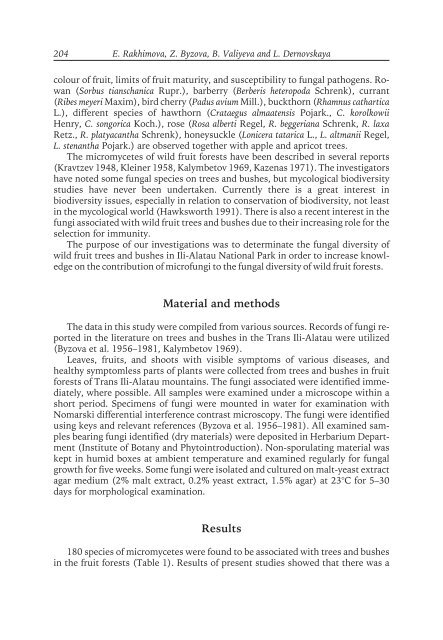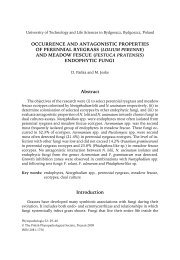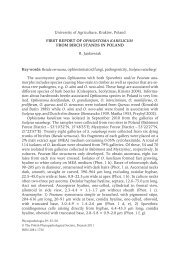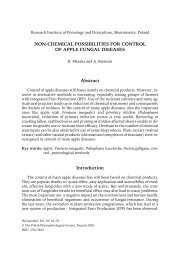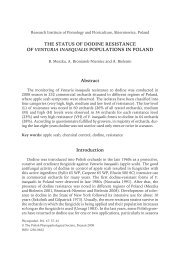diversity of microfungi in fruit forests of ili - Poznań
diversity of microfungi in fruit forests of ili - Poznań
diversity of microfungi in fruit forests of ili - Poznań
Create successful ePaper yourself
Turn your PDF publications into a flip-book with our unique Google optimized e-Paper software.
204 E. Rakhimova, Z. Byzova, B. Valiyeva and L. Dernovskaya<br />
colour <strong>of</strong> <strong>fruit</strong>, limits <strong>of</strong> <strong>fruit</strong> maturity, and susceptib<strong>ili</strong>ty to fungal pathogens.Rowan<br />
(Sorbus tianschanica Rupr.), barberry (Berberis heteropoda Schrenk), currant<br />
(Ribes meyeri Maxim), bird cherry (Padus avium Mill.), buckthorn (Rhamnus cathartica<br />
L.), different species <strong>of</strong> hawthorn (Crataegus almaatensis Pojark., C. korolkowii<br />
Henry, C. songorica Koch.), rose (Rosa alberti Regel, R. beggeriana Schrenk, R. laxa<br />
Retz., R. platyacantha Schrenk), honeysuckle (Lonicera tatarica L., L. altmanii Regel,<br />
L. stenantha Pojark.) are observed together with apple and apricot trees.<br />
The micromycetes <strong>of</strong> wild <strong>fruit</strong> <strong>forests</strong> have been described <strong>in</strong> several reports<br />
(Kravtzev 1948, Kle<strong>in</strong>er 1958, Kalymbetov 1969, Kazenas 1971).The <strong>in</strong>vestigators<br />
have noted some fungal species on trees and bushes, but mycological bio<strong>diversity</strong><br />
studies have never been undertaken.Currently there is a great <strong>in</strong>terest <strong>in</strong><br />
bio<strong>diversity</strong> issues, especially <strong>in</strong> relation to conservation <strong>of</strong> bio<strong>diversity</strong>, not least<br />
<strong>in</strong> the mycological world (Hawksworth 1991).There is also a recent <strong>in</strong>terest <strong>in</strong> the<br />
fungi associated with wild <strong>fruit</strong> trees and bushes due to their <strong>in</strong>creas<strong>in</strong>g role for the<br />
selection for immunity.<br />
The purpose <strong>of</strong> our <strong>in</strong>vestigations was to determ<strong>in</strong>ate the fungal <strong>diversity</strong> <strong>of</strong><br />
wild <strong>fruit</strong> trees and bushes <strong>in</strong> Ili-Alatau National Park <strong>in</strong> order to <strong>in</strong>crease knowledge<br />
on the contribution <strong>of</strong> micr<strong>of</strong>ungi to the fungal <strong>diversity</strong> <strong>of</strong> wild <strong>fruit</strong> <strong>forests</strong>.<br />
Material and methods<br />
The data <strong>in</strong> this study were compiled from various sources.Records <strong>of</strong> fungi reported<br />
<strong>in</strong> the literature on trees and bushes <strong>in</strong> the Trans Ili-Alatau were ut<strong>ili</strong>zed<br />
(Byzova et al. 1956–1981, Kalymbetov 1969).<br />
Leaves, <strong>fruit</strong>s, and shoots with visible symptoms <strong>of</strong> various diseases, and<br />
healthy symptomless parts <strong>of</strong> plants were collected from trees and bushes <strong>in</strong> <strong>fruit</strong><br />
<strong>forests</strong> <strong>of</strong> Trans Ili-Alatau mounta<strong>in</strong>s.The fungi associated were identified immediately,<br />
where possible.All samples were exam<strong>in</strong>ed under a microscope with<strong>in</strong> a<br />
short period.Specimens <strong>of</strong> fungi were mounted <strong>in</strong> water for exam<strong>in</strong>ation with<br />
Nomarski differential <strong>in</strong>terference contrast microscopy.The fungi were identified<br />
us<strong>in</strong>g keys and relevant references (Byzova et al.1956–1981).All exam<strong>in</strong>ed samples<br />
bear<strong>in</strong>g fungi identified (dry materials) were deposited <strong>in</strong> Herbarium Department<br />
(Institute <strong>of</strong> Botany and Phyto<strong>in</strong>troduction).Non-sporulat<strong>in</strong>g material was<br />
kept <strong>in</strong> humid boxes at ambient temperature and exam<strong>in</strong>ed regularly for fungal<br />
growth for five weeks.Some fungi were isolated and cultured on malt-yeast extract<br />
agar medium (2% malt extract, 0.2% yeast extract, 1.5% agar) at 23°C for 5–30<br />
days for morphological exam<strong>in</strong>ation.<br />
Results<br />
180 species <strong>of</strong> micromycetes were found to be associated with trees and bushes<br />
<strong>in</strong> the <strong>fruit</strong> <strong>forests</strong> (Table 1).Results <strong>of</strong> present studies showed that there was a


